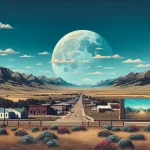Dinosaur National Monument spans over 200,000 acres across the Colorado and Utah border, preserving one of the world’s most significant fossil treasures. Besides natural history, there are also driving and hiking trails, wildlife viewing, and whitewater rapids on the Yampa River and the Green River for adrenaline junkies to experience.
In This Article
Keep reading to learn about all that Dinosaur National Monument has to offer for your trip.
TL;DR
- Dinosaur National Monument is renowned for its rich paleontological sites, including the famous Carnegie Quarry, which yielded over 350 tons of dinosaur fossils.
- The monument offers a glimpse into geological history, with exposed rock layers dating back billions of years and showcasing the region's transformation from an ancient sea to arid deserts.
- Visitors can explore the scenic canyons carved by the Green and Yampa Rivers, go whitewater rafting, hiking, and camping, and discover ancient Fremont petroglyphs and pictographs.
Geological and Paleontological Wonders
Dinosaur National Monument is a feast for the mind and the eye. Its exposed rock layers reveal a nearly complete stratigraphic column spanning from the Precambrian era (over 1 billion years ago) to the Miocene epoch (around 10 million years ago). The monument’s arid climate, with less than 12 inches of annual precipitation, allows for clear visibility of these geological formations, showcasing the tremendous forces of pressure, deposition, uplift, and erosion that shaped the area.
One of the monument’s most significant attractions is the Carnegie Quarry, where paleontologist Earl Douglass of the Carnegie Museum of Natural History discovered an extraordinary collection of dinosaur fossils in the early 20th century. Over 350 tons of fossilized bones were excavated, including mountable skeletons of iconic dinosaurs like Stegosaurus, Apatosaurus, and Allosaurus. Part of the quarry wall containing exposed fossils has been preserved within the Dinosaur Quarry Exhibit Hall, offering visitors a unique opportunity to witness these ancient remains in their original context.
Outdoor Adventures
Dinosaur National Monument offers a wealth of outdoor activities for adventurers. The Green River and the Yampa River, which have carved deep canyons through the monument’s rock layers, provide opportunities for thrilling whitewater rafting experiences. The Yampa River Canyon, in particular, is a must-see!
Hikers can explore scenic trails like the Harpers Corner Trail, which offers breathtaking overlooks of the winding river canyons. Split Rock, also called Split Mountain, offers stunning views from the summit as the southeast face drops 2,000 feet to the Green River below.
If you prefer a driving adventure, take the 10-mile Tour of the Tilted Rocks along Cub Creek Road.
For those seeking a more immersive experience, the monument’s backcountry offers camping, fishing, and biking opportunities amidst the stunning canyon landscapes. The Echo Park area, accessible by high-clearance vehicles, takes visitors deep into the heart of the monument’s rugged terrain. This is the spot where the Yampa River flows into the Green River.
Cultural Heritage and Archaeology
In addition to its geological and paleontological wonders, Dinosaur National Monument is home to a rich cultural heritage. The monument’s rock walls and overhangs feature an impressive collection of Fremont petroglyphs and pictographs, providing insights into the lives of the indigenous peoples who inhabited the region over 1,000 years ago.
These archaeological treasures and the monument’s well-preserved fossil sites have contributed significantly to our understanding of the area’s history and the evolution of life on Earth. Ongoing research and preservation efforts ensure these invaluable resources remain protected for future generations.
FAQ
What is the best time to visit Dinosaur National Monument?
The monument is open year-round, but the peak season is from late spring to early fall when temperatures are milder, and all facilities are fully operational. Summer can be hot, so early morning and evening visits are recommended.
How can I see the dinosaur fossils?
The Quarry Visitor Center on the Utah side of the monument is the starting point for visiting the Dinosaur Quarry Exhibit Hall, where dinosaur fossil remains are embedded in the rock wall. Guided tours are available during the peak season.
Are there any hiking trails suitable for families?
Yes, the monument offers several easy-to-moderate hiking trails, such as the Fossil Discovery Trail and the Sound of Silence Trail, which are suitable for families with children. If your kids are older, explore the River Trail that takes you to Split Mountain Canyon.
Can I camp inside Dinosaur National Monument?
Absolutely! The monument has several campgrounds, including the Green River Campground and the Echo Park Campground, which offer sites for tents and RVs. Other camping spots on the Colorado side of the national park include Deerlodge Park Campground and Gates of Lodore Campground. On the Utah side, you can camp at Green River Campground, Split Mountain Campground, and Rainbow Park Campground. Backcountry camping is also permitted with a free permit.






